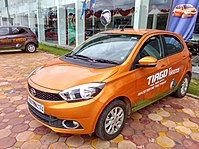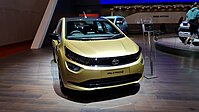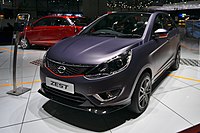Tata Motors Cars
 From Wikipedia - Reading time: 10 min
From Wikipedia - Reading time: 10 min
This article needs additional citations for verification. (December 2020) |
| Company type | Division |
|---|---|
| Industry | Automotive |
| Headquarters | Mumbai, Maharashtra, India[1] |
Area served | Indian Subcontinent |
| Products | Automobiles, Commercial Vehicles |
| Parent | Tata Motors |
| Website | cars |
Tata Motors Cars is a division of the India-based automaker Tata Motors which produces cars under the brand name Tata Motors. It is currently the 3rd largest car manufacturer in India in terms of sales after Maruti Suzuki, Hyundai and Mahindra in September 2024.[1][2]
History
[edit]
This section needs to be updated. (March 2020) |
Tata Motors entered the passenger vehicle market in 1991 with the launch of the Tata Sierra, a multi utility vehicle. This was followed by the launch of the Tata Estate in 1992 (a stationwagon based on the existing TataMobile light commercial vehicle) and the Tata Sumo in 1994, India's first sports utility vehicle.
Tata launched the Indica in 1998, the first fully indigenous Indian passenger car. Although initially criticised by auto-analysts, its excellent fuel economy, powerful engine and an aggressive marketing strategy made it one of the best selling cars in the history of the Indian automobile industry. A newer version of the car, named Indica V2, was a major improvement over the previous version and quickly became a mass favourite. Tata Motors also successfully exported large quantities of the car to South Africa. The success of Indica played a key role in the growth of Tata Motors.[2]
In January 2008, Tata Motors launched Tata Nano, the least expensive production car in the world at about ₹120,000 (US$3,000).[3] The city car was unveiled during the Auto Expo 2008 exhibition in Pragati Maidan, New Delhi.[4]
Tata has faced controversy over developing the Nano as some environmentalists like Anumita Roychoudhury, of the Centre for Science and Environment in Delhi,[5] and Rajendra K. Pachauri,[6] chairperson of the Intergovernmental Panel on Climate Change (IPCC), are concerned that the launch of such a low-priced car could lead to mass motorization in India with adverse effects on pollution and global warming.[7][8] Tata had set up a factory in Sanand, Gujarat and the first Nanos were rolled out in summer of 2009.[3]
Tata Motors Cars has launched further expansion into Southeast Asia by expanding into Vietnam and the Philippines.[4]
At the 12th Auto Expo in February 2014, Tata Motors unveiled The Bolt, a hatchback and The Zest, a compact sedan.[9] They are slated to launch in August 2014.[10]
Tata Motors increased its capital expenditure by 30 per cent to Rs 32,000 in order accelerate its shift toward electric vehicles
In 2020, there were plans for Chinese auto maker Chery to buy a percentage of Tata Motors in order for Chery (who already make Jaguar Land Rover[11] cars in a joint venture in China) to gain entry into the Indian market and in order for Tata Motors to get technology for cars such as the proposed Tata Blackbird.[12][13] However, due to Covid-19 and the continuing political tensions over the Chinese/Indian border and other geopolitical reasons it is extremely unlikely that the company Chery will buy any part of Tata Motors.
It was announced on May 30, 2022, Tata Motors signed an MOU with the Gujarat Government to acquire Ford India’s Sanand manufacturing plant.[14]
Products
[edit]Current Models
[edit]ICE Vehicles
[edit]| Model | Calendar year introduced |
Current model | Vehicle information | |
|---|---|---|---|---|
| Introduction | ||||
| Hatchback | ||||

|
Tiago | 2016 | 2020 | A-segment/city car hatchback. |

|
Altroz | 2020 | 2020 | B-segment/subcompact hatchback. |
| Sedan | ||||

|
Tigor | 2017 | 2020 | B-segment/subcompact sedan. |
| SUV/crossover | ||||

|
Punch | 2021 | 2021 | Subcompact crossover SUV |

|
Nexon | 2017 | 2023 | Subcompact crossover SUV (B-segment) |
| Curvv | 2024 | 2024 | Compact Coupe SUV (B-segment) | |

|
Harrier | 2019 | 2023 | Compact crossover SUV (C-segment) |

|
Safari | 1998 | 2023 | Mid-size crossover SUV |
Electric Vehicles
[edit]| Model | Calendar year introduced |
Current model | Vehicle information | |
|---|---|---|---|---|
| Introduction | ||||
| Hatchback | ||||
| Tiago.ev | 2022 | 2022 | A-segment/subcompact Hatchback. | |
| Sedan | ||||
| Tigor.ev | 2019 | 2021 | B-segment/subcompact sedan. | |
| SUV/crossover | ||||
| Punch.ev | 2024 | 2024 | Subcompact crossover SUV | |

|
Nexon.ev | 2020 | 2023 | Subcompact crossover SUV (B-segment) |

|
Curvv.ev | 2024 | 2024 | Compact Coupe SUV (B-segment) |
| Harrier.ev | 2024 | 2024 | Compact crossover SUV (C-segment) | |
Former Models
[edit]| Model | Released | Discontinued | Image |
|---|---|---|---|
| Telcoline | 1988 | 2010 | 
|
| Sierra | 1991 | 2003 | 
|
| Estate | 1992 | 2000 | 
|
| Sumo | 1994 | 2019 | 
|
| Indica | 1998 | 2018 | 
|
| Spacio | 2000 | 2011 | 
|
| Indigo | 2002 | 2018 | 
|
| Indigo Marina | 2006 | 2009 | 
|
| Xenon | 2007 | 2018 | 
|
| Sumo Grande | 2008 | 2016 | 
|
| Vista | 2008 | 2016 | 
|
| Nano | 2008 | 2018 | 
|
| Manza | 2009 | 2016 | 
|
| Venture | 2010 | 2017 | |
| Aria | 2010 | 2017 | 
|
| Zest | 2014 | 2020 | 
|
| Bolt | 2014 | 2019 | 
|
| Hexa | 2017 | 2020 | 
|
Manufacturing Facilities
[edit]- Pune (Maharashtra)
- Sanand Plant (Gujarat)
Concept vehicles
[edit]

- 2000 Aria Roadster
- 2001 Aria Coupe
- 2002 Tata Indica
- 2004 Tata Indigo Advent
- 2005 Tata Xover
- 2006 Tata Cliffrider
- 2007 Tata Elegante
- 2009 Tata Prima
- 2011 Tata Pixel
- 2012 Tata Megapixel
- 2014 Tata Nexon[15]
- 2014 Tata Connectnext[16]
- 2017 Tata Tamo Racemo
- 2018 Tata 45X Concept (Launched as Tata Altroz on 22 January 2020)
- 2018 Tata H5X Concept (Launched as Tata Harrier on 23 January 2019)
- 2019 Tata H7x (later known as Tata Gravitas and launched as Tata Safari on 15 Feb 2021)
- 2020 tata HBX Concept (Launched as Tata Punch on 18 Oct 2021)
- 2020 Tata Altroz EV (Expected Launch: TBD)
- 2020 Tata Sierra EV concept (Expected Launch: 2025)
- Tata E-Vision Electric
- 2022 Tata Curvv Electric
- 2022 Tata Avinya Electric (Scheduled to Launch In 2025)
- 2023 Tata Sierra.ev
- 2023 Tata Harrier.ev
References
[edit]- ^ "Archived copy". Archived from the original on 8 January 2016. Retrieved 28 June 2015.
{{cite web}}: CS1 maint: archived copy as title (link) - ^ "Tata Milestones". Archived from the original on 6 December 2010. Retrieved 22 March 2009.
- ^ "The Next People's Car". Forbes. 16 April 2007. Archived from the original on 1 May 2007. Retrieved 21 January 2008.
- ^ "Time to say hi to Tata's dream car". The Times of India. 10 January 2008.
- ^ Fred Attewill , "World's cheapest car upsets environmentalists", The Guardian, 10 January 2008
- ^ Gavin Rabinowitz, "Carmaker in India unveils $2,500 car", USA Today, October 2008
- ^ Colin Mathews, "Tata Nano Hits The Market, Environmentalists Sound Alarm", The Car Connection, 23 March 2009
- ^ Siddhartha Shome, "The Little Car that Environmentalists Love to Hate", The Breakthrough, January 2008
- ^ "Auto Expo 2014: Tata Bolt hatchback and Tata Zest sedan unveiled", Autocar India, 3 February 2014
- ^ Vikas Yogi, "Tata Zest and Bolt Coming in August: Sources", NDTV Auto, 20 May 2014
- ^ "Chinese automaker Chery rethinks partnership with Tata Motors". 29 May 2020.
- ^ M, Surendhar (1 February 2020). "Tata Blackbird SUV Concept Teased Ahead Of Auto Expo Unveil?". Gaadiwaadi.com.
- ^ "Tata Blackbird to launch soon? » MotorOctane". MotorOctane. 1 February 2020.
- ^ Livemint (30 May 2022). "Tata Motors to acquire Ford India's Sanand plant". mint. Retrieved 2 June 2022.
- ^ "Auto Expo 2014: Tata Nexon, Connectnext concepts unveiled", Autocar India, 5 February 2014
- ^ PTI,Tata Black Bird "Auto Expo 2014: Tata Motors unveils SUV Nexon, ConnectNext concept cars", The Economic Times, 5 February 2014
 KSF
KSF